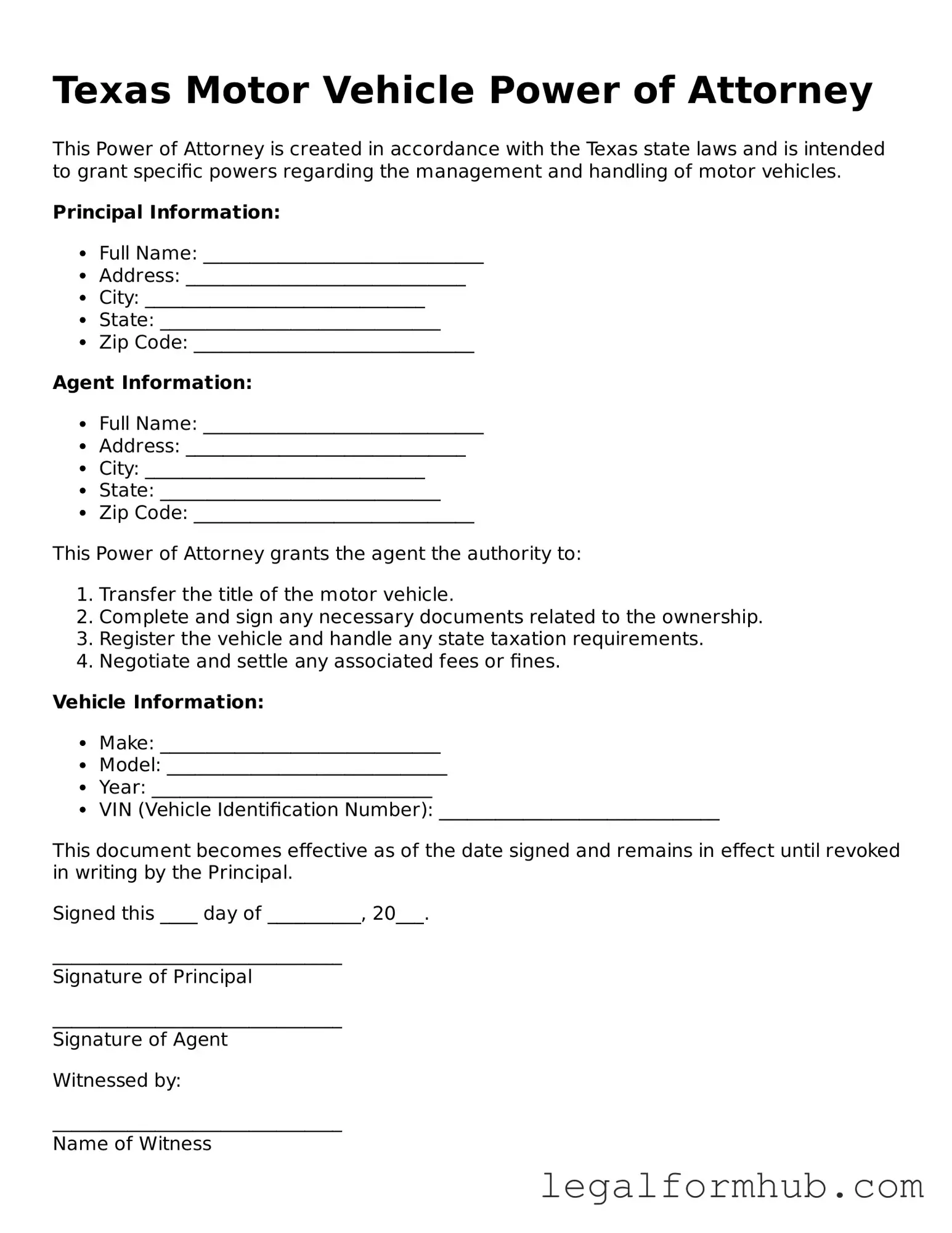The Texas Motor Vehicle Power of Attorney form is similar to a General Power of Attorney. Both documents allow an individual to appoint another person to act on their behalf. In the case of a General Power of Attorney, the authority granted is broader and can cover a wide range of financial and legal matters, not limited to motor vehicles. This flexibility makes it useful for various situations, from managing bank accounts to handling real estate transactions.
Another document akin to the Texas Motor Vehicle Power of Attorney is the Limited Power of Attorney. This form also allows an individual to designate someone else to act on their behalf, but the scope of authority is restricted to specific tasks or situations. For instance, a Limited Power of Attorney might be used solely for the sale of a vehicle, ensuring that the appointed person can only perform actions related to that particular transaction.
The Durable Power of Attorney shares similarities with the Texas Motor Vehicle Power of Attorney in that it remains effective even if the principal becomes incapacitated. This aspect is crucial for individuals who want to ensure their affairs, including vehicle transactions, can still be managed if they are unable to do so themselves. The Durable Power of Attorney can cover a wide range of decisions, much like a General Power of Attorney, but with the added benefit of continuity during incapacitation.
The Medical Power of Attorney is another relevant document, although it serves a different purpose. This form allows individuals to appoint someone to make medical decisions on their behalf if they are unable to communicate their wishes. While it does not pertain to vehicle transactions, it reflects the underlying principle of delegating authority to another person, similar to the Motor Vehicle Power of Attorney.
A Vehicle Bill of Sale is also comparable, as it is often used in conjunction with the Texas Motor Vehicle Power of Attorney. This document serves as a formal record of the sale of a vehicle, detailing the transaction between the buyer and seller. While it does not grant authority to act on behalf of another, it is an essential part of the vehicle transfer process, ensuring that both parties have a clear understanding of the terms involved.
In the realm of managing financial documents, having the right forms can significantly streamline operations. For instance, the Free And Invoice PDF form is an invaluable tool that makes it easy for individuals and businesses to create invoices that reflect their services or products accurately. By utilizing resources like Fill PDF Forms, users can take control of their invoicing needs, ensuring clarity and proper record-keeping for every transaction.
The Affidavit of Heirship is another document that can be related to vehicle transactions, particularly in cases of inheritance. This affidavit establishes the heirs of a deceased individual and can be used to transfer ownership of a vehicle without going through probate. While it does not function as a power of attorney, it serves a similar purpose in facilitating the transfer of property rights, including vehicles.
The Release of Liability form is also relevant. This document is used to inform the Department of Motor Vehicles that a vehicle has been sold or transferred, thereby releasing the seller from any future liability associated with that vehicle. While it does not grant authority to another person, it is a critical step in the vehicle transfer process, ensuring that the previous owner is no longer responsible for the vehicle.
Lastly, the Title Application form is comparable in that it is a necessary document for transferring ownership of a vehicle. This form is submitted to the DMV to officially register a vehicle in the new owner's name. While it does not involve delegating authority, it is part of the broader process that includes the Texas Motor Vehicle Power of Attorney, as it allows for the legal transfer of ownership from one party to another.
